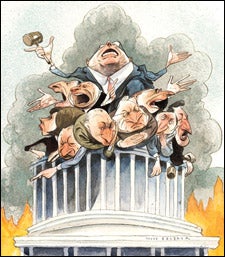“THERE’S NO DENYING that climate change is happening, and that we’ll soon be operating in a carbon-constrained world.”
Code Green

Boilerplate commentary from an eco-activist? No, that’s Jeffrey Sterba, incoming chair of the Edison Electric Institute, the nation’s largest power-industry trade group. And he’s not the only corporate kingpin who’s suddenly talking like he just finished a private screening of An Inconvenient Truth. Leaders at some of the country’s biggest utilities, including Exelon, Duke Energy, and PG&E, as well as at global energy companies like Shell Oil and BP-Amoco, have recently gone public with their support for federal action on climate change. Indeed, companies that have rightly been shellacked by enviros for being among the world’s biggest polluters are not only taking global warming seriously; they’re also joining the fight to enact federal legislation to control greenhouse-gas emissions. “For the first time in history,” says Congressman Tom Udall, a Democrat from New Mexico, “I bet we’ll actually be seeing big business lobby the administration for┬Śnot against┬Śclimate-change regulations.”
If you’re thinking the corporate world has suddenly gone granola on us, think again. It’s the bottom lineÔÇönot a surge of do-goodismÔÇöthat’s behind industry’s new green streak. As evidence of global warming piles up (and glaciers melt down), executives are realizing that it’s no longer a matter of whether climate regulations will happen but when, and how tough they’ll be. You don’t need an M.B.A. to see that corporations stand a better chance of getting a kinder, gentler climate policy now, while one of the era’s most conservative, big-business-friendly presidents is in the White House, than they will once a new administration takes over.
From a business standpoint, it’s far more economical to deal with predictable, manageable requirements on greenhouse-gas emissions in the near term than to face sudden, drastic restrictions later on. “The sooner we get started, the better,” Sterba told energy and environmental lobbyists at a recent conference in Washington, D.C. He called for a policy that reduces greenhouse emissions gradually, “allowing industry time to adjust.”
In reality, corporate America is already adjusting. Businesses with international operations (read: almost every major U.S. company) have been forced to comply with emissions-restriction laws in Europe, Japan, and other nations that signed the 2005 Kyoto agreement. It doesn’t make economic sense to operate polluting factories in one country and clean factories in another; it’s more efficient to deal with a continuity of laws across the board. The same rule applies domestically, where businesses face conflicting environmental lawsÔÇöand increasing pressure to go green. Seven states in the Northeast, for instance, have committed to voluntary carbon-dioxide reductions of 10 percent by 2019. Under Republican governor Arnold Schwarzenegger, California is requiring that planet-heating emissions be reduced 25 percent by 2020 (one of the pro-environment moves, incidentally, that helped fuel an impressive surge in his popularity, according to polls taken before his 2006 reelection).
There’s no telling what kind of policy changes the new corporate eco-speak might bring. But most enviros and industry types agree the most effective way to reduce corporate greenhouse-gas output┬Świthout dealing a blow to profits or passing big costs along to the consumer┬Śis through a carbon “cap and trade” system like the one mandated by Kyoto. It’s modeled after the program that has successfully reduced acid-rain pollution in the U.S. Put simply, the EPA would set a cap on overall carbon-dioxide emissions, and then grant each company an individual pollution allowance. Those that pollute less could benefit financially by selling unused pollution “credits” to companies whose factories are churning out more than the legal limit. The approach uses both sticks and carrots to send a clear message: Spewing greenhouse gases will cost you money, so find a way to clean up your act. “Placing a monetary value on carbon,” says David Slump, who heads GE Energy’s global-marketing division, “will accelerate the development and deployment of next-generation technologies.”
The big question is, will the new Democrat-controlled Congress finally make federal climate policy a reality? One thing’s certain: We can expect to see a flurry of legislative proposals floated in the House and Senate in coming months. But what happens next depends largely on how the Democrats decide to wield their new power. While “bipartisanship” was the buzzword for a few days last November, within weeks Dems were calling for investigative hearings, threatening to make GOP leaders pay for the long list of environmentally devastating policies they’ve rammed through Congress in recent years. Some amount of finger pointing will help set the record straight, of course, but too much could put the kibosh on what’s shaping up to be a historic opportunity for consensus building. Politicians of all stripes want to reduce America’s reliance on foreign oil and create a strong, clean-energy economyÔÇötwo goals that will in turn benefit the climate.
Sure, there are still V-8-size obstacles to enacting a national climate-change policy. U.S. carmakers, for example, will likely battle mightily to avoid legislation that forces them to invest in emissions-reducing technologies. “Detroit has tremendous power in Washington, especially among top Democrats,” says Dan Becker, director of the Sierra Club’s global-warming division. “The Big Three will fight to the death against any good climate bill that comes along.”
There are even environmentalists who will fight against certain climate bills, and with good reason. A fast-tracked plan might be riddled with industry-friendly loopholes that could actually set America’s climate policy back several years. In that case, greens would be better off holding out until the next administration, when a tougher plan of action might be possible. Jonathan Lash, president of the World Resources Institute, an environmental think tank, wants negotiations to start now, but cautions, “We could end up with Potemkin legislation┬Śsomething that looks good, with a lot of nice scenery, but is ultimately two-dimensional and won’t do anybody any good.”
Even if Congress does manage to pass something that both enviros and industry support, the buck still stops in the Oval Office, where President Bush has veto power. Yet Bush himself has said that foreign-oil dependence makes America vulnerable, and that a good way out is to develop new sources of alternative energy. Plus, as Udall puts it, “Emerging markets for clean technologies could create millions of new American jobs. It’s the single biggest global economic opportunity on the horizon.”
Some Beltway prognosticators think the White House may come around. The president is vulnerable in the wake of the 2006 elections and what most perceive as a failed war in Iraq, goes this line of thinking. Enacting groundbreaking climate-change legislation might be Bush’s best shot at patching up his tattered legacy.
Not gonna happen, you say? Maybe so. But then, who’d have thought, nine months ago, that the Democrats could sweep Congress? In these mercurial times, anything is possible.


